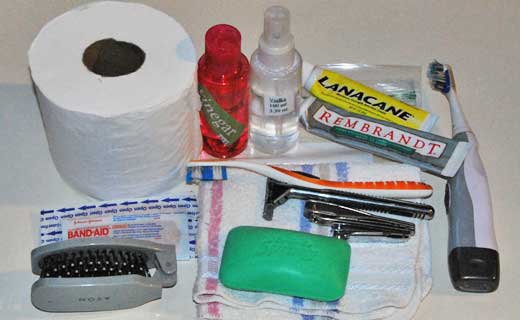Personal Care Items for Europe
Pack Your Toothbrush and Toilet Paper
Most of what you need is in your bathroom right now.
Your essential items for daily hygiene and grooming include toothbrush, toilet paper, razor, hairbrush and other toiletries. My vinegar is in the airline size 3 ounce red bottle and my vodka is in the adjacent spray bottle. Both, along with toothpaste and Lanocane, are on the one quart zip baggie which is
required for all liquids, pastes, and gels on board. Also shown are the other basic bathroom items — soap, washcloth, clippers, and bandaids.
I suggest that you carry this inventory in your airline carry-on bag to allow for checked luggage being lost. A spare set of undies should also be in that carry-on bag. You never know what is happening next in our world.
Carpe diem. Vivere bene! Gratia Deo.
Chapter 6 part 2 of
HOW TO EUROPE:
The Complete Travelers Handbook
John Bermont
This entire book is published totally free on-line by the author, photographer, and webmaster, yours truly, with help from my daughter Stephanie. I welcome all questions, comments, compliments, and complaints. For contact information please see NOTE TO READERS. Updated 17 December 2015.
Think — think again — pack.
This Internet edition of chapter 6 is divided into four parts because it is so big. The four parts are:
- Pack Light Field Test: Travel Europe in Comfort and Style.
- Personal Care Items for Europe: Pack Your Toothbrush and Toilet Paper.
- Travel Supplies: Pack a Bunch of Small Stuff.
- Packing Valuables: Not in Your Luggage.
The first part of my packing chapter is one of the most important aspects of traveling in Europe. It is also one of the most difficult for Americans to grasp. If you didn't read the guidelines for the Pack Light Field Test I urge you to do so before you go any further.
This part will focus on the stuff you use every day to clean up and make yourself presentable to your world. If you just grab the stuff you normally use you will probably need the trunk of your car. We are not going there. We're going on a plane and then on trains around Europe.
DAILY DRILL
Your Bedroom Dresser
You will need your toothbrush and a few other items of personal hygiene while you travel. Check your bathroom sink, tub, and the top of your bedroom dresser for those things that you use on a regular basis. Toothbrush, toothpaste, razor, dental floss, and nail clippers come to mind. Most women have additional things. You know what you use in the bathroom every morning so you are the best list maker for these little items.
3-1-1 Liquid Packing Rule
Worldwide air security regulations limit the amount of liquids that can be brought on board in carry-on luggage. Liquids, aerosols and gels must be in containers with a maximum capacity of 3.4 ounces and all of these containers must be carried in a one quart re-sealable transparent plastic baggie, one baggie per passenger. To save last minute packing you might want to buy an extra mini tooth paste, contact lens solution, mouthwash, and other essentials so you can pack your one quart Ziploc® baggie early. If you are traveling with a companion, save some donkey duty by splitting your list and sharing the use of normal necessities.
Packing
If you are checking luggage do not put these daily items in your big bags. Put them in your carry-on bag. Also, make sure you have a spare pair of boxers, socks, t-shirt, and an outer shirt in your carry-on bag. Ladies, you know the equivalent of my list. The reason for carrying these undies in your carry-on is that your checked luggage might not arrive when you do. When making airplane connections, especially in Europe, my experience is about 50% on having my checked luggage arrive when I do. It arrives two or three days later.
Re-stock
If you are traveling for a long period don't bother bringing along enough of everything for the whole trip. You can stop in any grocery, drug, or department store for your consumables. In fact you can leave all of your liquid products at home, especially if it means the difference between checking or not checking a bag on the plane. Airplane temperature and pressure, especially in the baggage hold, are lower than ground conditions. Liquids can leak and/or freeze and present the potential for serious consequences in an airplane. If you have any liquids in your checked luggage double wrap them in Ziploc® bags. You don't want them leaking out into your shoes. This happened once when I packed a couple cans of Heinekin beer for a trip to St. Louis where I feared that Bud might be the only "beer" available. One of the cans sprung a leak due to low pressure at flight altitude and wetted my suitcase.
ELECTRICAL APPLIANCES
The Fundamentals
European electric voltage and frequency are not the same as in the USA, and the plugs are different. Before you think about bringing any of your electrical gear to Europe read my chapter 11 on electricity, in two parts. First, get up to speed and throw away any notions of bringing a converter after reading Electric Converters in Europe: Why You Should NOT Pack One. Then get familiar with the various plug adapters and other hardware you might need in Electricity in Europe: Travel Voltage Fundamentals.
Your Appliances
Many items used in the home are not suitable for travel, and some will not work in Europe. If you use an electric razor, hair blower, hair straightener, travel iron, or other electric appliances check them over carefully before you pack them for your trip. If the nameplate says ~120 volt only, and not ~120~240 (dual voltage), leave it home. It will not work in Europe. I am getting more and more letters from readers telling me their story of sparks and amazing lights, followed immediately by losing all electricity in their room, after plugging in their 110 volt hair blower or power surge strip. You can't put ten gallons of water in a five gallon pail and you can't run 240 volts through a 110 volt machine. Note that voltages are approximate — 120 volt covers the range of 110 to 130 and 240 covers the range of 220 to 250.
Another number on your appliances is the frequency, Hz. Due to the lower frequency in Europe, 50 Hz versus 60 Hz in the USA, items with motors will run slower in Europe.
The power required by these appliances is considerable, especially for hair blowers and irons. It is 500 to nearly 2,000 watts. If you bring a dual voltage unit with you then also bring an adapter plug for it. Do not plug heating items into power surge strips.
Power surge strips are designed for small electronic items. Make sure that your power surge strip is rated for 240 volts. American power surge strips are only rated for 120 volts. Most of them will give you a startling fireworks display. Play it safe and get one that is certified for 240 volts unless you want to burn the hotel down.
Electronic gizmos such as battery chargers for laptop and netbook computers, cameras, and phones are generally dual voltage and can be used in Europe, if you have a plug adapter. Most of them state 110-240 volt and 50/60 Hz. Check the nameplate to be sure. If you have a few of these things with you, as I do, a power surge strip will allow you to charge everything overnight. European hotel rooms rarely have a spare electrical outlet, and if they do it is behind the bed headboard.
There are several types of electrical outlets and plugs used in Europe. Most of the Continent uses a plug with two round prongs. Britain and Ireland have a different style, as does Switzerland and Italy. See chapter 11 for the full story.
Here are notes on the personal care electrical gadgets that many travelers are inclined to pack. You'll have to think for yourself on this to decide what you want to bring. There are as many packing lists as there are travelers, multiplied by the number of destinations and seasons.
Electric Razor
An electric razor with rechargeable batteries and dual voltage charger (110/220) is quite handy. With this baby you can shave anytime and anyplace in minutes as long as you keep your batteries charged. It will present only an occasional nuisance because special outlets for electric razors in many newer or refurbished hotels will not supply enough power to operate the charger. In such cases, use a regular outlet in the room to charge the battery.
Hair Blower
Hair blowers are a standard American appliance. If you use a normal high watt 120 volt hair blower leave it home. Your sink-size blower will require a ten pound transformer. You'd rather carry around a watermelon. If you feel you need a hair blower, purchase a compact dual voltage model designed for travelers. You can buy this in most department stores in the USA and Europe, at a duty free shop before boarding your plane, or from Amazon using the advert link in the right column on this page.
You probably don't need to carry a hair blower with you anyway. Most hotels now have a hair blower permanently wired in. Even the B&Bs, hostels, and university dorms I have stayed in over the past several years have a hair blower in the room. I guess they do this out of self defense, to prevent clients from popping the circuit breakers with the mega-watt blowers they are inclined to bring with them. If you make advance reservations ask your hotel(s) if the room has a hair blower.
A hair blower can be used for more than one thing. Occasionally it will come in handy for drying your clothes, whether rained on or washed in your room. I used mine one night to furnish heat in a freezing German hotel room.
If you notice that the lights in your room start to dim or flicker when you turn on your hair blower, turn off everything but the one light you really need. Dimming lights means that the hotel or hostel wiring is old. You may blow a fuse if you keep everything turned on. Yup, I've done that.
Travel Iron
This is something that most travelers will not need. If you are doing your own laundry in your room, hang it up above the tub and let it drip dry. It won't look perfect when you put it on, but nothing does after an hour of wear anyway.
For a quick touch up, ask your hotel if they have an iron to loan or if there is a nearby pressing shop. Test the hotel's iron on a towel to make sure it is clean before laying it on your clothes.
If you do carry an iron, buy a compact dual voltage travel iron. See the advert for a model from Amazon in the right column on this page. There are other models available at Amazon but make sure that whatever you buy is dual voltage. Some dual voltage appliances come with an adapter plug but most do not.
LIQUIDS AND LOTIONS
Shampoo
I've come to the conclusion that shampoo is one of the most worthless substances known to man. Right next to it is hair conditioner. Why wash all the natural oils out of your hair just to put back a mixture of overpriced perfumed chemicals from another fancy bottle? Try washing your hair in water for a week and see if you find yourself presentable. If so you can scratch two bottles of chemicals from your packing list. You'll also be saving some environmental damage that went into making the stuff and extra expense at the wastewater treatment plant getting rid of the excess chemicals before they reach our beautiful fish. I haven't used shampoo for years.
A reader, Nanette from Manila, wrote to suggest using baking soda solution as a shampoo. She recommended a tablespoonful of soda to a cup of water. This is followed by a rinse of a tablespoonful of white vinegar in a cup of water. I tried it and it works great. My straw turns to silk. She said that she originally learned of this from the site Simple Mom. I find it easier to apply the baking soda if I put a spoonful in a tiny cup, dump it on my wet head, and rub it in. I use one of those plastic cuppies from a bottle of cough syrup.
Mouthwash
Casual reading of the labels of some of those green and blue bottles in the drugstores reveals the fact that they are full of many ingredients, including alcohol at a concentration of up to 26%. Some of the ingredients are poisons so you won't want to drink the stuff. There is another form of alcohol which will kill most of those germs causing bad breath, but won't kill you unless you really try. It will just make you feel warm and comfortable. It's called vodka, normally about 40% alcohol. I sometimes use vodka as mouthwash before bed. It has other uses as described in the next part of this chapter, "Traveler's Supplies."
Dental Chewing Gum
You will probably take most of your meals in public places. Meanwhile your toothbrush is parked at your hotel. Carry a supply of dental chewing gum so you can clean your teeth on the fly. Products containing xylitol are tasty and effective. Xylitol is an anti-bacterial sweetener which occurs naturally in some plants. My favorite brand is Spry™ and it comes in a number of flavors. See the Amazon advert in the right column or buy it in a health food store. Xylitol is also claimed to be effective in controlling nose problems, i.e. runny nose and pains. I can attest to that. It is effective and acts quickly. You'll get over those sniffles and sneezes tight now.
Deodorant and Antiperspirant
Body odor is the stink put out by bacterial action on your perspiration. There are two ways to stop the odor. You can stop the perspiration or stop the bacteria. A third way is to cover up the snmell with perfume. I call that the French way.
One thing to be aware of is that many deoderants contain aluminum compounds as antiperspirants. A high level of aluminum in the brains of deceased Alzheimer's persons is a common factor of the disease. The cause of Alzheimer's disease is not known and there is no cure. It would be prudent to avoid putting more aluminum in or on your body until the medical investigators find out what is happening. An internet search turns up a number of reports from doctors and researchers indicating a high level of alarm over aluminum. Alzheimer's disease is an excruciatingly debilitating disease affecting 10% of Americans over 65 and 50% of those over 86 years old. I have first hand experience in supporting my 90 year old Mother who died of Alzheimer's after about 4 years with the disease.
Another problem with antiperspirants which block the sweat glands is that the fluid can accumulate under the skin and become infected. That is a nasty, ugly, and painful problem. It happened to my brother. A doctor in the emergency room gave his underarm a two second peek and pronounced "shingles." Do not trust all doctors.
Instead of using over priced deodorants try vodka. Vodka snuffs these stink producing bacteria. High strength isopropyl alcohol is more effective than vodka, and much cheaper. Vinegar is also a very effective deodorant. It is mildly acidic and kills odor causing bacteria. The vinegar leaves your skin refreshed and the odor is gone in minutes.
Popular deodorants also contain a brew of other chemicals. The spray versions usually contain butane and other flammable gases derived from crude oil, with appropriate warnings against using the product near an open flame. You could blow your house up with a few cans of this stuff.
If your body wants to perspire let it do so and take a shower. If you are not ticklish you can let a dog lick your arm pit. Dogs love that salty perspiration.
Vinegar
Have an open mind as you read this section. I don't know why but I get criticized a lot for my advocacy of vinegar in some unconventional applications. Heck, just because your moma didn't teach you about vinegar doesn't mean that other advice shouldn't be considered.
For dry hands, a vinegar rub works better, quicker, and lasts longer than the fancy expensive á-la-gooey products. Just don't get vinegar in your eyes. It stings real good in an open wound also, but is excellent in calming down minor skin irritations and in relieving itchy scalp. One reader wrote in suggesting vinegar as a hair rinse. I've started doing that after showering.
Speaking of eyes, a small spray bottle of vinegar can act as a junior version of Mace®. Mace® is not allowed in hand baggage on the plane. Vinegar is innocous, or so it would seem. But if you hit a thug in the face with a squirt you can buy enough time to flee. I have never done this but considering the increasing incidence of violent crime in some major European cities I think I'll carry a small spray bottle in my day bag from now on.
Vinegar makes a good deodorant. Swab it in your armpits. The vinegar aroma is gone quickly. A reader sent me this tip. It works.
You can shave without the foamy stuff using vinegar instead of shaving cream. It softens your whiskers so well that you won't feel them being cut. Rub the vinegar onto your face and let it soak in for a few minutes. Give it another go before shaving. Some readers of this chapter have written that they doubt that this works and some are afraid of the vinegar sting if they get a nick. Yes, it does work and I shave this way every day. No, you won't get a stinging nick, and so what if you do? You're a man and you don't whimper, do you?. Most likely you will be surprised that there are no whiskers left because there was no tug on your razor or sandpaper sound as you shaved.
I use vinegar to soften the whiskers even when I use my electric razor.
People who are queasy about putting vinegar on their face should look at the ingredients list of any popular shaving foam. It's a brew of unheard-of chemicals. My brother's overpriced aerosol can has ingredients of stearic acid, triethanolamine, isobutane, laureth-23, and others. After reading that list I go with vinegar any day.
If you buy a small bottle of vinegar in a grocery store after you arrive, transfer it to a plastic bottle if it isn't already packaged that way. Do not buy the high strength 25% acid variety sold in Germany. Get the normal 5% solution.
Vitamins
If you're in the habit of popping a few alphabet pills every morning, don't forget to pack a supply.
I buy a tube of 1,000 mg (that's one gram) vitamin C tablets at a pharmacy after arrival in Europe and then walk into any pharmacy when I'm running low and simply show them the tube to buy more. That way you only have to translate it once. Tip: write down "Vitamin C" and show it to the clerk. It's spelled about the same all over Europe but pronounced much differently. Some vitamin C tablets look and act like "Alka-Selzer." Drop them in a glass of water or juice and they fizz up and dissolve. They come in various flavors. Multi-vitamins are also available in these fizz pills.
Notice that I have an advert in the right column for valerian. This is a natural herbal food supplement. It has amazing relaxant properties. If you have trouble sleeping this is what you want. I use it for helping to sleep soundly on the plane to Europe and preventing jet lag. Some people, even doctors, confuse valerian with valium. Valerian and valium are totaly different.
Vodka
Vodka is the diminutive Russian and Polish word for water. Vodka is distilled grain alcohol, though it is also made from potatoes in Poland. Whiskey and brandy are also alcohols, made by fermentation of grains and fruits with subsequent distillation. There are many types of alcohol and most of them are poisons. Vodka, whiskey, and brandy contain ethyl alcohol, also known as ethanol. It is safe in moderate amounts. You would fall off your chair drunk before it killed you. It is normally 40% alcohol, 80 proof. Some brands are a higher concentration.
As with vinegar, some people have written unfavorably about my advocacy of alcohol. Alcohol has been around for multi millennia and has quite a few worthwhile uses.
- Vodka can disinfect cuts and scratches. This is painful, but very effective in preventing infection and helping the healing process. I saw a professional bottle of anti-septic at a nursing home that contained one active ingredient, ethyl alcohol, and it was guaranteed to kill 99.99% of the bacteria that it contacted. How many soldiers and cowboys would have died of infections if it wasn't for a bottle of whiskey to disinfect their wounds? It also helps to control the pain.
- Use it to knock out a cold better than any cold medicine on the market. In the evening, down a pint of vodka or brandy, bundle up with more on than you would wear in an Arctic howl, and sweat it out. You might still be drunk in the morning, but voila! — no cold. Use a good quality (triple or quadruple distilled) product to avoid a hangover and a headache the next morning. My preference is Hennessy cognac, with or without fresh squeezed lemon juice. I call it my Dr. Hennessy. The traditional bowl of chicken soup, also known as Jewish penicillin, also helps to snap a cold or flu.
- If you are beset with crabs or other body lice, soak a handkerchief in vodka and sponge around the infested areas. The vodka will dehydrate the little buggers and get rid of them surer and safer than those other products. Wash out your clothes in very hot water to get the strays.
- As mentioned in a previous section, alcohol can also be used as a mouthwash, disinfectant, and deodorant. You see it on the ingredients lists of just about all of those products, even though it is usually listed as an "inactive" ingredient. That is suspicious. Why are all the products using alcohol as an "inactive" ingedient?
- It's also a nice refreshing aftershave, without the perfumes.
So, if only for medicinal purposes, carry a bottle of firewater. Yes, it does burn. You can buy it in the duty free shop before you leave, or duty free on the plane, though these are usually liter bottles and are pretty heavy. Ask your flight attendant for a couple extra 50 ml airline bottles while the in-flight bar is still open. These are free on most international flights, though the flight attendant is not likely to give them to you if she knows that you are taking them with you. Just a few years ago one miserly KLM flight attendant even poured my vodka for me, but she only gave me half of the tiny 50 ml bottle!
If you are "underage" you probably won't have to worry about that in Europe. In many countries you can buy distilled spirits at age 18, and beer at age 16. Be careful if you are drinking for the first time. Alcohol has a profound effect on your behavior and body coordination.
Isopropyl Alcohol, IPA for short
IPA is normally called rubbing alcohol. It is available in strengths from 70% to 91% at your pharmacy and 99% at your hardware store. I use that industrial grade.
IPA is an effective anti-bacterial agent. It kills every germ in the house. It can kill humans also. Do not drink it or you will die, painfully. IPA is also flamable and the vapors are explosive. Did somebody say that smoking can be harmful?
Another good use for IPA is to use it as an insecticide. It is cheap and effective at knocking down flying and creeping critters without the dangerous chemicals normally used in insecticides. IPA is poisonous but it evaporates in a minute and leaves no residue. I keep a small spray bottle handy in the kitchen. No fly goes out on his wings and no ant walks home.
Medical Bag
Your rudimentary first aid bag should include at a minimum:
- Band-Aids®
- Antiseptic ointment, e.g. Neosporin®
- Aspirin, Ibuprofen®, or equivalent
- Anti-itch cream, e.g. Lanacane®
- Antihistamine, e.g. Fexofenadine Hydrochloride
Of course, don't take this stuff just because "Dr. John" said the drugs are OK. Read the labels and contra-indications and talk with your doctor if you have any reason to question using these over-the-counter treatments. The FDA has issued a warning about Ibuprofen®. This is no laughing matter. I recently had a serious reaction after taking Ibuprofen® for years. I have quit all pain meds except for benzocaine products. I use weed when I am in Holland and would anyplace else where it is legal. I am sick of Big Pharma running incessant TV adverts for their pain drugs. I think those ads are crafted to induce a headache in a normal person. You know how it is when someone in a group yawns. Everybody immdeiately follows. Same goes for the aching actors.
Other products to consider are discussed in chapter 20, Health and Safety in Europe: Travel in Confidence but with Caution.
Toilet Paper
Everybody I know needs this once a day or so. Trouble is that not every potty in Europe provides it, even when you pay to take a dump. The last potty customer may have decided to take the roll home, or put it in his/her day bag, or the facility just does not take care of their restrooms like they do at the Golden Arches. You have to give McDonalds a high five for keeping spotless facilites patrolled by a good staff in white shirts and ties. Heck, in local restaurants and cafes it is still pssible to find the "eastern style" squat toilet. Maybe that roll of paper on the floor is what it should be.
Regardless, just about any local eatery in Europe is preferrable to any American fast food chain joint. Therefore BYOTP is a phrase to live by.
In Your Day Bag
Of all the items discussed on this page I suggest that the only two which you really should carry around in your day bag are TP and dental chewing gum. There are other things also, e.g., map, guide book, dictionary, etc., but not too much. See the discussion of a tote in chapter 7, Luggage for Europe: Let It Roll.
CONTINUATION
Part 1 of this chapter served as a introduction to packing light, with a simple user's manual for the Pack Light Field Test. Actually that is just a few paragraphs. If you missed it go to Pack Light Field Test: Travel Europe in Comfort and Style. You don't want to be a pack mule while vacationing in Europe.
This part 2 has more specific packing details covering your personal hygiene needs while traveling, Personal Care Items: Your Toothbrush and Hair Blower. Most of it is in your bathroom or on your dresser right now. But before you throw everything in your bag look over this essay to see if you really want to do that.
Part 3 of my packing suggestions covers the traditional stuff you need on the road. See Travel Supplies: Pack a Bunch of Small Stuff. Here you'll find the big list of little things — calculator, compass, electrical devices, guide books, laundry supplies, maps, tool kit, Swiss Army Knife, toilet paper, watch, wire ties, and more.
Lastly, part 4 discusses the vaulable things you will be bringing with you. This includes your passport, camera, and other ID and valuables. The key message, which bears repeating, is do not put these things in any luggage, back pack, day bag, or purse. Carry them on your person. See Packing Valuables: Not in Your Luggage..
Last Call
If you want to skip over all the verbiage in this chapter and go straight to a quick check-off packing list then see The Finale, Last Call: Travel Prep and Pack Lists for Europe. Come back here later to see why you need vinegar and vodka, but you can pick up those items on your way.
Have a good trip!
NOTE TO READERS
I welcome questions, comments, complaints, and compliments. If you have any concerns about your trip to Europe that have not been covered well enough on my web site please do not hesitate to write. Ask, cuss, discuss, or whatever. I read every email and update my pages when I see a question repeating, Then I will not get that question again, hopefully. In some cases readers have been so generous with their time and talent that I have included their emails verbatim, e.g. chapters 22 and 25.
I do not open attachments. I do not click links to web pages of any kind. I will reply in a day or two, usually.
My email address is [email protected].
Do not forget to smell the hyacinths. At your liesure scroll through the Table of Contents of How To Europe: The Complete Travelers Handbook and read all 30 chapters, FREE on line. Good deal! You'll probably find the answers you seek, and some you didn't know you needed.
FREE
This web site is totally free for everyone, and a labor of love for me. To keep it afloat I receive a commission from Amazon.com for all goods purchased through the adverts I have selected, and any other products you might buy when you are on the Amazon site. Amazon has almost everything for sale, except the Brooklyn Bridge and Mount Rushmore.
Please visit my on-line store at
 .
Your support is most gratefuly appreciated. TIA.
.
Your support is most gratefuly appreciated. TIA.
To like and like not:


Adverts
To support this site:
Please buy your goods at:Amazon.com
Shop in your shorts!
Please clean out your cookie jar before clicking.
This dental chewing gum can help keep your choppers in good order when you travel.
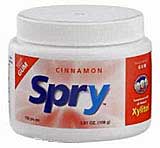 Spry Chewing Gum 100 ea
Spry Chewing Gum 100 ea
Ths traditional shaving soap is light and compact, and saves the trouble of bringing an aerosol can of shaving cream, or my alternative vinegar.
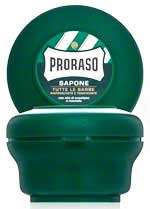 Proraso Shaving Soap, Eucalyptus & Menthol, 5.2 oz (150 ml), New Formulation
Proraso Shaving Soap, Eucalyptus & Menthol, 5.2 oz (150 ml), New Formulation
This German made double-edge safety razor is one of the best available.
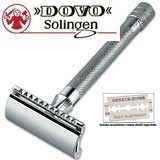 Merkur Model 180 Long Handled Safety Razor
Merkur Model 180 Long Handled Safety Razor
Make sure that your electrical appliances are 110-220 dual voltage so they will work in Europe.
Note:
These appliances require a plug adapter, NOT a converter, for the countries you are visiting. See plug adapters above.
#E-130
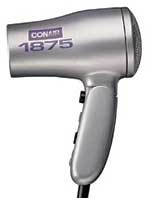 Vagabond Compact Styler
Vagabond Compact StylerConair's Dual-Voltage Ionic Hair Dryer
#E-140
 Conair Flat Iron 2" Ceramic Straightener
Conair Flat Iron 2" Ceramic StraightenerDual Voltage
#E-150
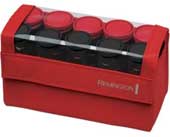 Travel Hair Setter
Travel Hair SetterDual Voltage
Remington H-1015
#E-160
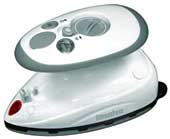 SteamFast SF-717 Home-and-Away Mini Steam Iron (dual voltage)
SteamFast SF-717 Home-and-Away Mini Steam Iron (dual voltage)
#E-170
 Braun Series 1 150 Men's Shaver with Automatic Worldwide Voltage Adjustment
Braun Series 1 150 Men's Shaver with Automatic Worldwide Voltage Adjustment
For light sleepers here is an international "white noise" machine. Includes a Continental plug adapter.
#E-180
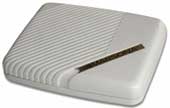 Marsona TSCi-330 White Noise Travel Sound Conditioner For both USA and International
Marsona TSCi-330 White Noise Travel Sound Conditioner For both USA and International
For coffee or tea in your room, without waiting or paying for room service.
#E-190
 Lewis N. Clark Immersion Heater 120/240V
Lewis N. Clark Immersion Heater 120/240V
Plug adapters are needed throughout Europe. There are at least five models used in different countries.
Note: The highlighted #E number is purely arbitrary. It is meant to help quickly identify products in this advert column when you write in for electrical advice.
See NOTE TO READERS.
This adapter is for the standard grounded plug in France, Germany, and northern Europe. It does not fit in outlets of Italy, Switzerland, Ireland, and Britain.
#E-010
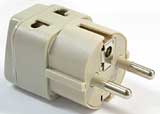 Grounded Universal 2 in 1 Plug Adapter
Grounded Universal 2 in 1 Plug Adapter
European Schuko plug.
4.8 mm prongs.
Equivalent to type E and F.
You can use this ungrounded Euro plug in some European countries.
#E-020
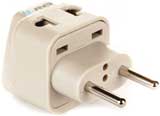 Universal 2 in 1 Plug Adapter
Universal 2 in 1 Plug Adapter
Euro Plug
4.0 mm prongs.
Equivalent to type C.
This is a universal plug adapter for the UK and Ireland.
#E-030
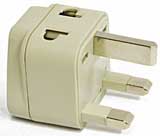 AC Adapter Plug for use in England, Scotland, Wales, and Ireland
AC Adapter Plug for use in England, Scotland, Wales, and Ireland
Equivalent to type G.
Here is the Swiss version.
#E-040
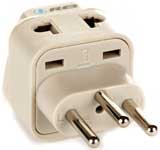 Grounded Universal 2 in 1 Plug Adapter
Grounded Universal 2 in 1 Plug Adapter
Type J for Switzerland
Here is the grounded Italian model.
#E-050
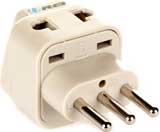 Grounded Universal 2 in 1 Plug Adapter
Grounded Universal 2 in 1 Plug Adapter
Type L for Italy
This 110-250 volt power surge strip has three universal outlets and an American grounded plug so it needs a plug adapter for the countries you are visiting. Make sure your gizmos are rated for 110-240 volts.
#E-060
 SM-60 Universal 3 Outlet Power Strip Surge Protector for Worldwide Travel. 110V-250V with Overload Protection.
SM-60 Universal 3 Outlet Power Strip Surge Protector for Worldwide Travel. 110V-250V with Overload Protection.
If your gizmos charge through a USB port this can keep you going. European cars have the same 12 volt system as American cars.
#E-200
 Scosche Dual USB
Scosche Dual USBCar Charger
The links in this pink field take you directly to a page at Amazon.com. The Amazon page details the item, and in most cases includes candid and critical comments from others who have bought the item.
Amazon pays my site a small commission when you click and order an item, if you put it in your shopping cart within 24 hours based on the cookie they set on your computer. If you don't want to make a quick decision just put it in your shopping cart, think it over, and come back later. The revenue covers the cost of maintaing this web site and keeps it free to users.
You benefit when buying here because Amazon has:
- 20% - 30% discount on many items,
- free shipping deals, direct to your door,
- no sales tax on internet purchases in most states,
- zillions of products, well almost,
- fast delivery even when it is free,
- shipment tracking in UPS, USPS, FedEx,
- easy returns if you are not happy with the product.
You win we win. Thanks for your support!!
Have a good trip in life,
John Bermont
Note: Italicized notations by the author.
For small appliances travelers may find these true transformers useful. They deliver the full sine wave. Caution: The wattage rating is the max short term. For continuous duty I recommend that you select a transformer rated at two times the combined watts of all gizmos plugged it. But check your gizmo's electrical specification plate before buying one of these. Most electronic devices are dual voltage and can be plugged in any European outlet when using the appropriate plug adapter.
This 50 watt 220/110 volt step down transformer is good for very small 110 volt appliances and light duty chargers.
#E-070
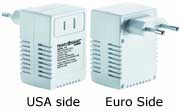 Travel Smart by Conair 50-Watt International Transformer
Travel Smart by Conair 50-Watt International Transformer
This 200 watt step up/down transformer is good for small appliances.
#E-080
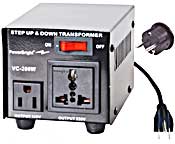 Power Bright VC200W Voltage Transformer 200 Watt
Power Bright VC200W Voltage Transformer 200 WattStep Up/Down
110/120 Volt-220/240 Volt
A Swiss Army Knife is unquestionably the handiest item a traveler can carry, except not on a plane.
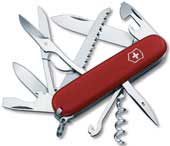 Victorinox Swiss Army Huntsman II Knife
Victorinox Swiss Army Huntsman II Knife
Absolutely the best battery for digital cameras which use AA batteries.
#E-120
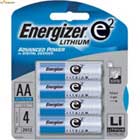 Energizer
EnergizerAA Lithium Batteries
4 Pack
This will come in very handy very often.
 Fenix LD15
Fenix LD15High Performance
LED Flashlight
Wear a scarf for comfort and style. Nobody will ever suspect that you are an American.
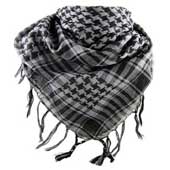 Very soft houndstooth neck scarf. Various colors available
Very soft houndstooth neck scarf. Various colors available
